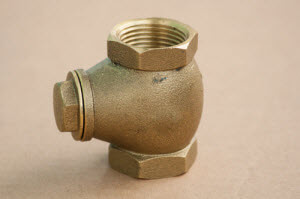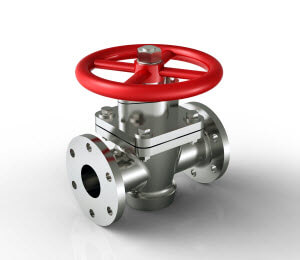Types of Check Valves and Their Recommended Applications
Check valves are one of the most important valves for any system, whether for industrial equipment or a household item. They’re critical for ensuring the proper operation and to prevent reverse flow and damage. However, types of check valves are designed for a specific application.
To help you choose the right check valve for your needs, here are a few of the most common types of check valves and their recommended applications.
Types of Check Valves: Swing Check Valves
 Swing check valves feature a simple design complete with a disc attached to a hinge at the top. As fluid passes through, the valve remains open. When a reverse flow occurs, the changes in motion as well as gravity help to bring down the disc, effectively closing the valve.
Swing check valves feature a simple design complete with a disc attached to a hinge at the top. As fluid passes through, the valve remains open. When a reverse flow occurs, the changes in motion as well as gravity help to bring down the disc, effectively closing the valve.
These types of check valves are commonly used for firefighting and flood prevention in sewage systems. They’re also designed to work with materials such as gas, liquids, and other types of media.
Types of Check Valves: Stop-Check Valves
Stop-check valves can be used for many applications. They’re designed to start, stop, and regulate the flow of materials, and they help to prevent backflow.
If pressure in the system is too low, these valves will automatically close to prevent reverse flow. As a result, damage usually caused by backflow is prevented.
 These types of check valves also work with an external mechanism or an override control. With these, you can set the valve to close regardless of flow direction or pressure to ensure safety and efficient operations.
These types of check valves also work with an external mechanism or an override control. With these, you can set the valve to close regardless of flow direction or pressure to ensure safety and efficient operations.
Generally, stop-check valves are used in power plants and boiler systems. They’re also beneficial for petroleum production and refining, hydrocarbon processing, and high-pressure safety services.
Types of Check Valves: Ball Check Valves
Unlike other valves, ball check valves use a spherical ball inside their bodies to help control the flow direction in pipes and systems. This ball rotates freely when fluid passes through the system, which causes a wiping motion and even wear between the ball and seat. According to Valve Magazine, this unique action makes ball check valves ideal for systems working with viscous materials.
If pressure decreases or reverse flow is detected, the ball will move toward the seat. This creates a seal and helps to maintain the appropriate direction of fluid flow.
Ball check valves are one of the most common valves available. Industrial systems as well as common household items use them. In fact, The Valve Pipeline states that ball check valves can be found in liquid or gel mini-pump dispenser spigots, spray devices, and manual air pumps.
On top of that, ball check valves are used for metering pumps and chromatography pumps as well.
Types of Check Valves: Silent Check Valves
Silent check valves are incredibly useful for water pipelines and systems. These valves are engineered to control and protect against pressure surges that can occur in water lines. They also work to prevent water hammer and reverse flow.
Silent check valves are constructed with a spring-assisted disc. When fluid pressure in the valve is higher than the cracking pressure, or the pressure needed open or close the valve, the spring lowers the disc to prevent reverse flow.
The valve is also manufactured to include a guide to keep the disc moving in a vertical. This allows it to reseat properly.
Contact CPV Manufacturing for more information regarding the types of check valves and their recommended applications.
